A healthy 11-year-old female presents with a rash about the face
Click Here to Manage Email Alerts
A healthy 11-year-old female presents with a rash about the face, including the eyelids. The rash first appeared about 2 months earlier as simple, uninflamed papules. They were initially thought to be a reaction to some new sunscreen, as some seemed to disappear while others occurred. They are described to be mildly pruritic and occasionally seen to have some inflamed skin about the area. Some similar lesions appeared on her right knee, which were thought to be related to insect bites. Her past medical history reveals no other pertinent health problems, including skin disorders, and no allergies were noted.

Examination reveals normal vital signs and normal exam, except for numerous discrete fleshy papular lesions scattered on the face, including the eyelids, some of which have some white material extruding, whereas others are umbilicated (Figures 1 to 3). There are also some small patches of erythema apart from the papular lesions, as well as a thin base of erythema under a few of the lesions.
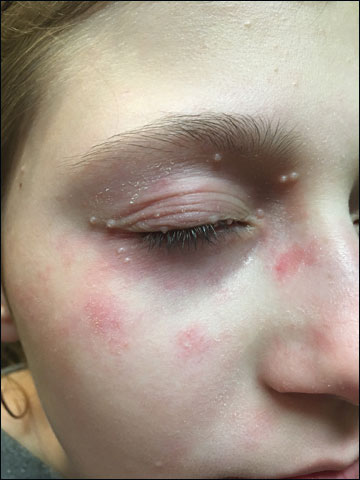
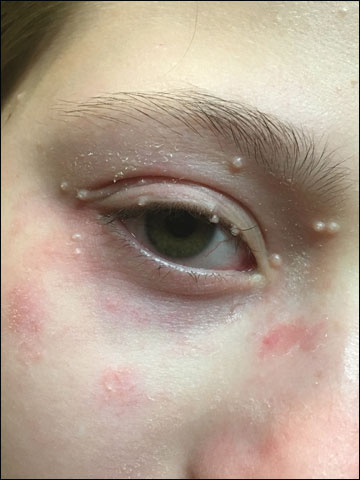
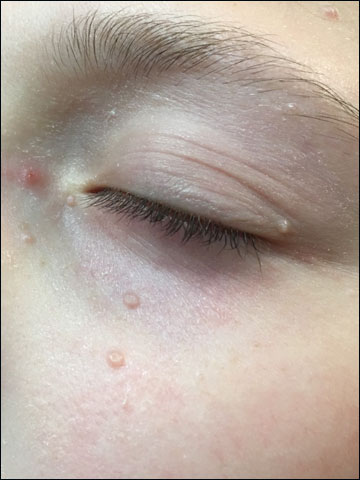
Source: James H. Brien, DO
No lab or imaging was done.
What’s your diagnosis?
A. Eczema herpeticum
B. Acne vulgaris
C. Molluscum contagiosum
D. Scabies
Case Discussion
The answer is C, molluscum contagiosum (MC). These common, irritating (both psychologically and occasionally physically), harmless lesions are caused by a poxvirus and, as the name implies, are contagious. The appearance is fairly characteristic, with a fleshy or waxy papule that umbilicates and occasionally will spontaneously extrude from the central white core containing the virus, making it easy to spread. They can be difficult to eradicate but are usually managed with topical agents and/or cryotherapy. Some older children will tolerate curettage, which is quick and effective. When located in a sensitive area, such as the eyelid, they are best managed by a dermatologist in the office setting. Ultimately, if the patient’s immune system is normal, they always resolve, but may take many months. It is advisable to test the immune system if there is an unusually large number (> 100), or if they persist over a long time. This case eventually resolved (Figures 4 and 5) after numerous visits to the dermatologist for topical therapy with liquid nitrogen on a cotton-tipped applicator.
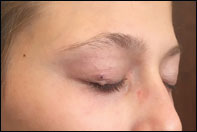
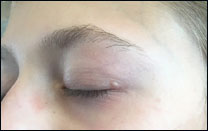
Some self-applied topical therapies can result in erythema of the surrounding skin, as shown. Another complication is secondary infection of a lesion. These can usually be managed with topical mupirocin.
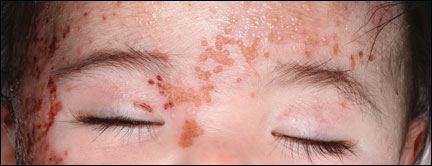

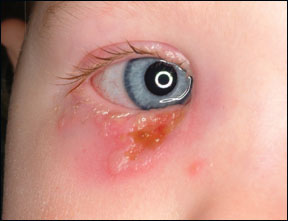
I think most would be able to tell the difference between MC and acne vulgaris, which is characterized by the presence of comedones, mostly on the forehead, face and chin areas, but can be almost anywhere, except the eyelids.
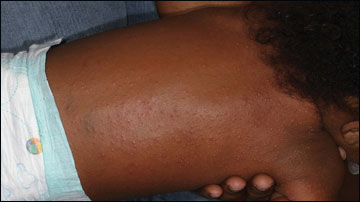

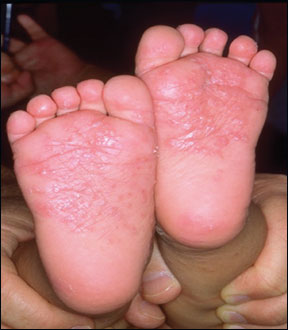
Eczema herpeticum, on the other hand, can occur anywhere, including the eyelids (Figure 6). However, eEczema hHerpeticum will only happen on children with underlying skin damage, usually due to eczema or atopic dermatitis (Figure 7). You don’t have to have eEczema hHerpeticum to get HSV herpes simplex virus on the eyelid (Figure 8). These infections should always be treated with aAcyclovir, and if there is any question about involvement of the eye, an oOphthalmologist should be involved.
Scabies usually starts out as very pruritic papular lesions that become excoriated, often with open lesions from scratching. In children, scabies can occur anywhere, but the face is uncommonly involved, and I have never seen scabies on eyelids. The papule that cannot be reached to scratch open will often appear to contain a small pustular top (Figure 9). In young children, it is not unusual to see scabies involving the palms and soles (Figures 10 and 11). The itching is the main clue, but this may be manifested as irritability in babies. Treatment of scabies is usually with either 5% pPermethrin cream or iIvermectin (200 µgmicrograms / kKg), two2 doses of either one, given one 1 week apart.
This would seem like a good time to remind you of the availability of three3 new references. The first is the 2018 Nelson’s Pediatric Antimicrobial Therapy, a handbook that is in its 24th edition, by the esteemed John D. Nelson, MD, professor emeritus of pediatrics at the University of Texas Southwestern Medical Center and Southwestern Medical School in, Dallas, Texas, and John D.S. Bradley, MD, professor of pediatrics at the University of California, San Diego School of Medicine, and director of the infectious diseases service at, Rady Children’s Hospital. I have been using Nelson’s pocketbook almost daily since 1982 (the 4th edition), when I started my fellowship, which I still have (and signed).
The next is the Red Book 2018. The Red Book and Nelson’s Pediatric Antimicrobial Therapy can be obtained from the AAP bookstore online at a discount to academy members.
The third is Sarah Long’s new 5th edition of Principles and Practice of Pediatric Infectious Diseases. If you have these great references, you can do everything I do in everyday practice, and put me out of business.
- References:
- Bradley JS, Nelson JD, eds. 2018 Nelson’s Pediatric Antimicrobial Therapy. 24th edition. Itasca, IL: American Academy of Pediatrics; 2018.
- Kimberlin DW, Long SS, Brady MT, Jackson MA, eds. Red Book 2018: Report of the Committee on Infectious Diseases. 31st edition. Itasca, IL: American Academy of Pediatrics; 2018.
- Long SS, Prober CG, Fischer M, eds. Principles and Practice of Pediatric Infectious Diseases. 5th edition. Philadelphia, PA: Elsevier; 2017.
- For more information:
- James H. Brien, DO, is with the department of infectious diseases at McLane Children’s Hospital, Baylor Scott & White Health, Texas A&M College of Medicine in Temple, Texas. He also is a member of the Infectious Diseases in Children Editorial Board. Brien can be reached at: jhbrien@aol.com.
Disclosure: Brien reports no relevant financial disclosures.
